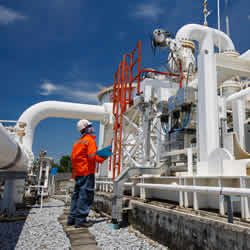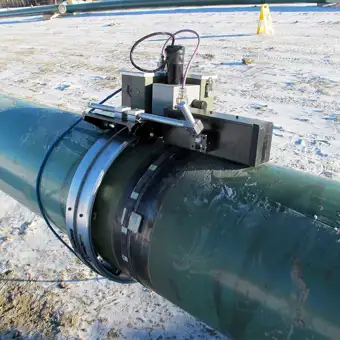Advanced Strategies in Pipe Welding Examination: Technologies and Technologies for Improved Precision and Reliability in Weld Assessment
The landscape of pipeline welding assessment is going through a considerable improvement, driven by innovative strategies that assure to boost both precision and integrity in weld evaluations. Advancements such as automatic assessment systems and advanced imaging innovations are redefining standard methods, while non-destructive screening approaches make certain product stability is preserved.

Significance of Weld Examination
Guaranteeing the stability of pipe welds is vital to the total security and integrity of commercial systems. Welds serve as the architectural foundation of pipes, which transfer a range of liquids under differing pressures. Problems in welding can lead to disastrous failings, causing not only substantial economic losses however additionally possible ecological calamities and hazards to public safety and security. Consequently, extensive inspection of welds is essential to the lifecycle of pipeline facilities.
The relevance of weld examination prolongs beyond mere conformity with governing requirements. It functions as a proactive measure to identify and rectify blemishes, such as insufficient combination, porosity, or cracks, prior to they rise right into major issues. Effective inspection strategies additionally add to the long life of pipelines, decreasing maintenance costs and enhancing functional effectiveness.
Additionally, extensive weld evaluations foster count on among stakeholders, including regulative bodies, financiers, and the areas served by these pipes. By guaranteeing that all welds meet the called for standards, companies can reduce threats and support their track records. In recap, weld assessment is vital not just for functional stability yet also for the more comprehensive implications it holds for safety and security and environmental stewardship.
Automated Assessment Systems
The combination of computerized evaluation systems in pipe welding has actually transformed the strategy to guaranteeing weld top quality and integrity. These systems utilize innovative robotics and synthetic knowledge to perform inspections that are not only quicker yet also much more regular than typical methods. Automated systems can cover substantial sizes of pipes efficiently, capturing data that human examiners may overlook because of tiredness or ecological problems.
Among the vital advantages of automatic examination systems is their capability to run in harmful settings, minimizing the risk to human examiners. They use different non-destructive testing (NDT) techniques, such as ultrasonic screening and magnetic bit examination, to examine weld integrity without compromising the structure. The data gathered is refined in real-time, enabling prompt responses and prompt corrective actions when defects are identified.
Moreover, automated systems promote the standardization of assessment procedures, guaranteeing that each weld is assessed versus consistent criteria. This not only enhances the integrity of outcomes but likewise simplifies compliance with regulative standards. As markets proceed to focus on safety and operational performance, the role of automatic inspection systems in pipeline welding will unquestionably increase, leading the way for more innovative quality control methods.
Advanced Imaging Technologies
Frequently used in modern-day pipe welding examinations, advanced imaging technologies have actually significantly boosted the ability to find and analyze weld flaws. Methods such as digital radiography, calculated tomography, and thermographic imaging supply inspectors with high-resolution images that disclose sub-surface imperfections and structural variances that may be undetectable to the nude eye.
This leads to faster evaluations and improved accuracy in determining vital defects. Calculated tomography, on the other hand, uses three-dimensional imaging, making it possible for examiners to picture intricate geometries and assess the integrity of welds from numerous angles.
Thermographic imaging employs infrared innovation to detect variations in temperature level, identifying areas of potential weak point or stress and anxiety within the weld. These advanced imaging technologies not just boost defect discovery prices but also reduce the time and resources needed for pipe assessments. As an outcome, they play a critical duty in keeping pipeline safety and reliability, ensuring conformity with sector criteria while lessening operational risks.
Non-Destructive Testing Approaches
Making use of different techniques, non-destructive screening (NDT) techniques are vital in pipeline welding inspections, permitting the analysis of weld honesty without endangering the material's structural integrity. NDT includes a variety of methods, including ultrasonic screening (UT), radiographic testing (RT), magnetic particle screening (MT), and dye penetrant screening (PT) Each method has distinctive advantages and applications depending on the certain needs of the examination.
Ultrasonic screening utilizes high-frequency audio waves to spot inner problems, providing specific measurements of weld thickness and honesty. Pipeline Welding Inspection. Radiographic testing utilizes X-rays or gamma rays to generate photos of the weld, exposing inner problems that may not be noticeable externally. Magnetic bit screening works for finding surface and near-surface gaps in ferromagnetic products, while dye penetrant screening highlights surface area cracks by utilizing a tinted color
Including these NDT methods into pipe welding assessments improves website here the precision and integrity of weld assessments, making sure that possible failures are determined early. As sectors demand greater criteria for safety and security and performance, the duty of NDT in maintaining the stability of welded frameworks continues to be crucial in pipeline building and upkeep.

Future Patterns in Weld Analysis
As we seek to the future of weld assessment, innovations in innovation are poised to change the techniques employed for reviewing Visit This Link pipe honesty. The combination of expert system (AI) and device learning in examination processes is anticipated to improve the accuracy of imperfection detection and anticipating maintenance. These technologies permit real-time data analysis, allowing assessors to determine possible issues prior to they rise into substantial problems.
Furthermore, the usage of drones geared up with sophisticated imaging systems is gaining traction. These airborne inspections can cover substantial areas swiftly, recording high-resolution images and information that can be analyzed for problems in hard-to-reach areas. This not only improves safety and security but likewise boosts effectiveness in the evaluation procedure.
In addition, the advancement of smart sensing units installed in pipeline systems uses the capacity for continual tracking. These sensing units can find modifications in pressure, temperature level, and vibrations, giving beneficial understandings into the health and wellness of the welds over time.

Conclusion
Finally, the integration of advanced methods in pipeline welding assessment significantly enhances the precision and dependability of weld assessments. Technologies such as computerized examination systems, progressed imaging modern technologies, and non-destructive testing approaches play an important role in enhancing defect detection rates and fostering aggressive maintenance techniques. As these innovations continue to advance, here are the findings they will better make sure the security and efficiency of pipe systems, eventually adding to the stability of essential framework.
